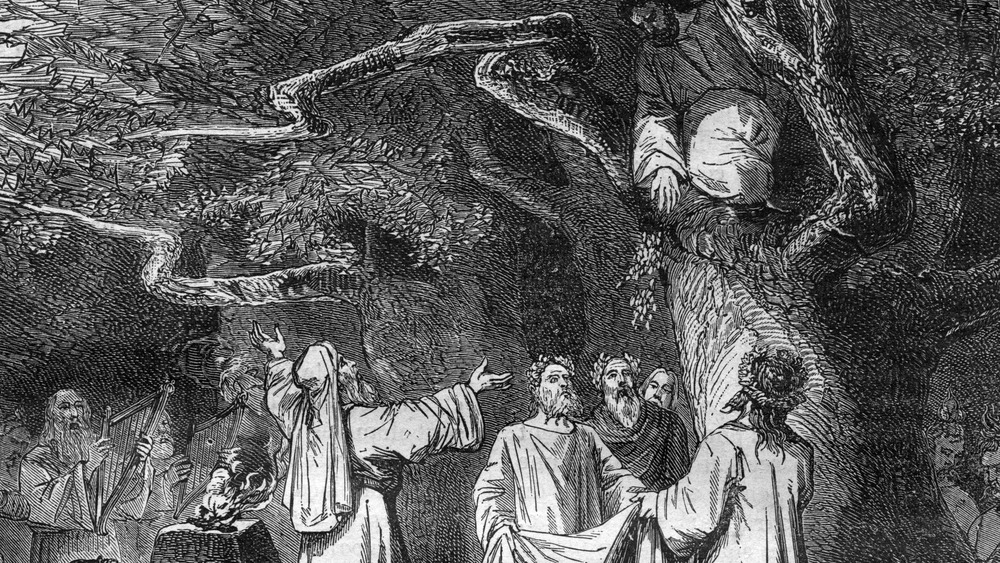Why Do We Hang Christmas Wreaths?
As with most holidays, Christmas is rife with symbols that we take for granted, but of course there is lots of rich history behind them. Just like Christmas trees, candy canes, and mall Santas, the tradition of hanging wreaths had to start somewhere, and exactly where kind of depends on who you ask. Lots of people now link the wreath to the crown of thorns placed on the head of Jesus Christ when he was crucified. The New York Times wrote that the pointed leaves of the holly wreath represent the thorns and the red berries represent Jesus' blood. While this may be the meaning behind such a wreath for many Christians today, this symbol didn't start out representing this imagery.
The crown of thorns connection has been picked up by others, as well, including Bustle, Metro, and possibly your mom, but the reality is that, like the entire tradition of Christmas itself, the wreath's roots don't lie in Christian soil at all (sorry, mom). Take a deeper look into where all the hall decking, tree trimming, and ho-ho-hoing comes from, and you'll find that the origins of the Christmas wreath and other holiday beliefs and traditions often go back to pagan rituals linked to the natural world and the changing of the seasons. The ancient Romans, Druids, Celts, and Egyptians all used wreaths long before Santa Claus came to town.
Yes, hanging Christmas wreaths started as a pagan ritual
According to CBS News, the history of Christmas dates back to pagan rituals meant to celebrate the passing of the winter solstice, the shortest day and longest night of the year. "Christmas is really about bringing out your inner pagan," said historian Kenneth C. Davis. His research shows that Christmas is linked to the Roman feast of Saturnalia, celebrated on December 25, the day of the winter solstice on the ancient Roman calendar. When Christianity replaced the old pantheistic beliefs of the Romans, that day became Christmas. (If it ain't broke ...) "There's a little discrepancy about it but there's no question that the fact that it was celebrated in Rome as an important day with gift giving, candle lighting, and singing and decorating houses really cemented Christmas as December 25," said Davis.
As Ancient Origins notes, the use of Christmas wreaths in Christian celebrations of the holiday go back to as early as 1444, and 16th-century Germans wove evergreen branches into a circle to represent God's never-ending love. Wreaths were used in pagan solstice rituals among the ancient Druids, Celts, and Romans for centuries before that. The circular shape of the wreath was meant as a symbol of victory, honor, and the continuing cycle of life that is to come after the shortest day of the year. According to Wear Your Voice magazine, even the ancient Egyptians used wreaths at solstice time, but they used palm fronds instead of evergreens.
Other fun pagan Christmas traditions
As Davis told CBS, pretty much all of the Christmas traditions that have been adopted by Christianity, and later neoliberalism, began as pagan customs — even the Christmas tree. It's no wonder we decorate evergreens each Christmas, as they represented the continuity of life through winter for the solstice-celebrating pagans. "They started to hang an apple on it, so little red balls on green trees — get the picture here?" he said. "So all of these things celebrate the idea that life and light are coming back into the world, which is essentially what Christmas means to Christians around the world." The tradition of hanging mistletoe above doorways came from the Druids, who attributed healing properties to it and used it to symbolize peace. Davis said that it "was such a powerful symbol of paganism that English churches actually banned the use of it."
The roots of Christmas are so pagan that the first-ever "war on Christmas" was actually waged by Christians themselves. Davis said that 17th-century puritans were well aware of the origins of these customs, and actually banned the celebration of Christmas in America for 20 years to try and stamp them out. It's inevitable that symbols will change and be adapted to fit modern beliefs, so rather than going all Puritanical on them, why not just remember that the holidays are really about spending time with those you love?


